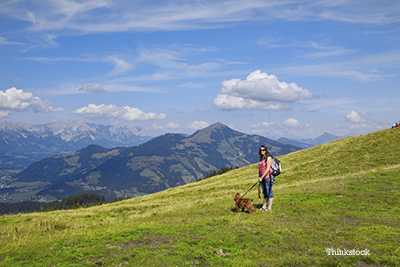For more from Dr. Ruth MacPete,find her on Facebook or at www.drruthpetvet.com!
 Hiking is a great activity for people and pets. Besides the beautiful scenery and fresh air, you get a healthy dose of exercise. Before you set out on a hike with your pet, here are a few things you should know.
Hiking is a great activity for people and pets. Besides the beautiful scenery and fresh air, you get a healthy dose of exercise. Before you set out on a hike with your pet, here are a few things you should know.
Know the Rules
First make sure the trail allows dogs. Some allow dogs but only if they are on a leash, while others do not allow dogs at all. Most trails post signs at the trailhead to inform you if pets are permitted. Know the rules before you hit the trail. No one likes to arrive at the trailhead with a very excited pooch only to find out that no pets are allowed. Although it may be tempting to break the rules, do so at your own risk. Most parks have rangers who are not afraid to issue citations. It may not seem like a big deal but a ticket can a lot of money.
Know Your Pet’s Ability
Be sure your dog is in good shape and can complete the hike. Otherwise, you may find yourself carrying them back. Some dogs, especially brachycephalic breeds and small dogs, do not have much stamina and cannot physically handle strenuous hikes. Others are just sedentary and don't enjoy hiking. Years ago, I used to hike with my Doberman and Scottish terrier. My Dobie could hike for miles and miles and would never tire. My Scottie, on the other hand, loved hiking on level ground or downhill but would refuse to hike uphill. After having to carry my twenty-five pound Scottie uphill a few times, I learned my lesson and bought a dog backpack carrier. She loved it and I loved it because it was easier than carrying her in my arms. The main point is make sure you know your pet’s limits and don’t exceed them.
Stay Hydrated
Be sure to bring plenty of water for yourself and your pets. Just like you, your pet will need to drink a lot of water while hiking in order to stay hydrated. The heat and exercise can lead to dehydration quickly if you and your pet are not drinking enough. Never assume you will find water on a trail. You never know when a stream or creek is going to be run dry. Also, drinking water from a stream is a good way to get intestinal parasites like giardia. Make sure you bring enough water for you and your pet and don’t forget to bring a collapsible bowl for your pet since it’s not easy for them to drink from a water bottle.
Hiking Dangers
When hiking, always stay on the designated trails to avoid disturbing wildlife or damaging native plants. In addition to obeying the rules and helping protect the environment, staying on the trail can actually save your dog’s life. Poisonous snakes are found in every state except Alaska, Hawaii, and Maine. Although you may not realize it, you and your pet may not be the only ones enjoying the hiking trails on a warm summer day. By keeping your pet leashed and on the trails, you can pull your dog away from danger and keep them out of a snake’s favorite hiding place, like brush and piles of rubble. For more info about poisonous snakes and what to do if your pet is bitten, read my previous blog on poisonous snakes. While not as dangerous as a venomous snake, plants with thorns and cacti are a common outdoor hazard for your pet. Keeping your pet leashed and on the trail can protect them from becoming a cactus pincushion. Keeping them on a leash will also keep them out of harm's way by keeping them away from cliffs, waterfalls, and rivers. After you finish your hike, check your dog’s fur and in between their toes for thorns, cactus stickers, foxtails, and burrs, and always make sure to look for ticks, especially if you live in an area endemic for Lyme disease.
In line with the Boy Scout motto, being prepared can make all the difference in the world between an enjoyable outdoor excursion and wilderness misadventure. Before you set out on a hike, know the trail rules and bring plenty of water for yourself and your pet. Remember to keep your pet on a leash and on the trail. Afterwards, check their fur and feet closely after hikes. Hiking is a great activity that people and pets can enjoy together. Hopefully these tips will help you and your pet stay safe on the trails this year.
If you have any questions or concerns, you should always visit or call your veterinarian – they are your best resource to ensure the health and well-being of your pets.
